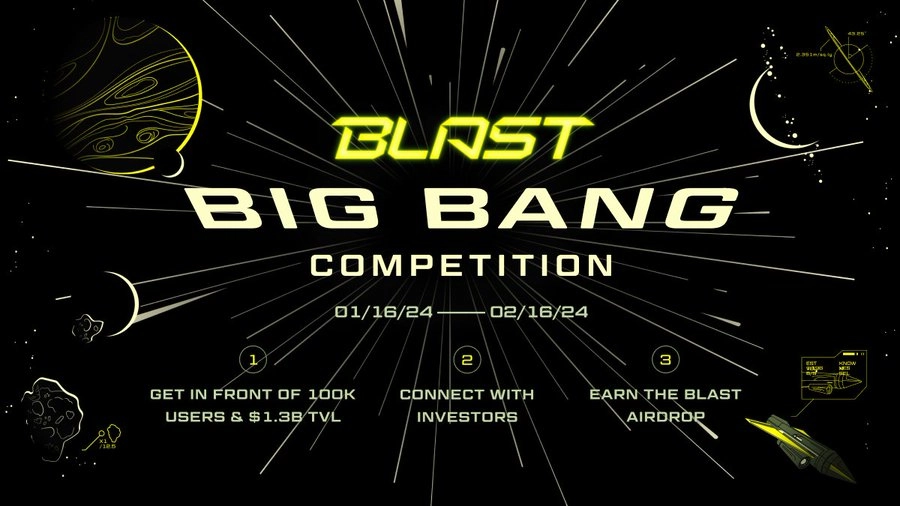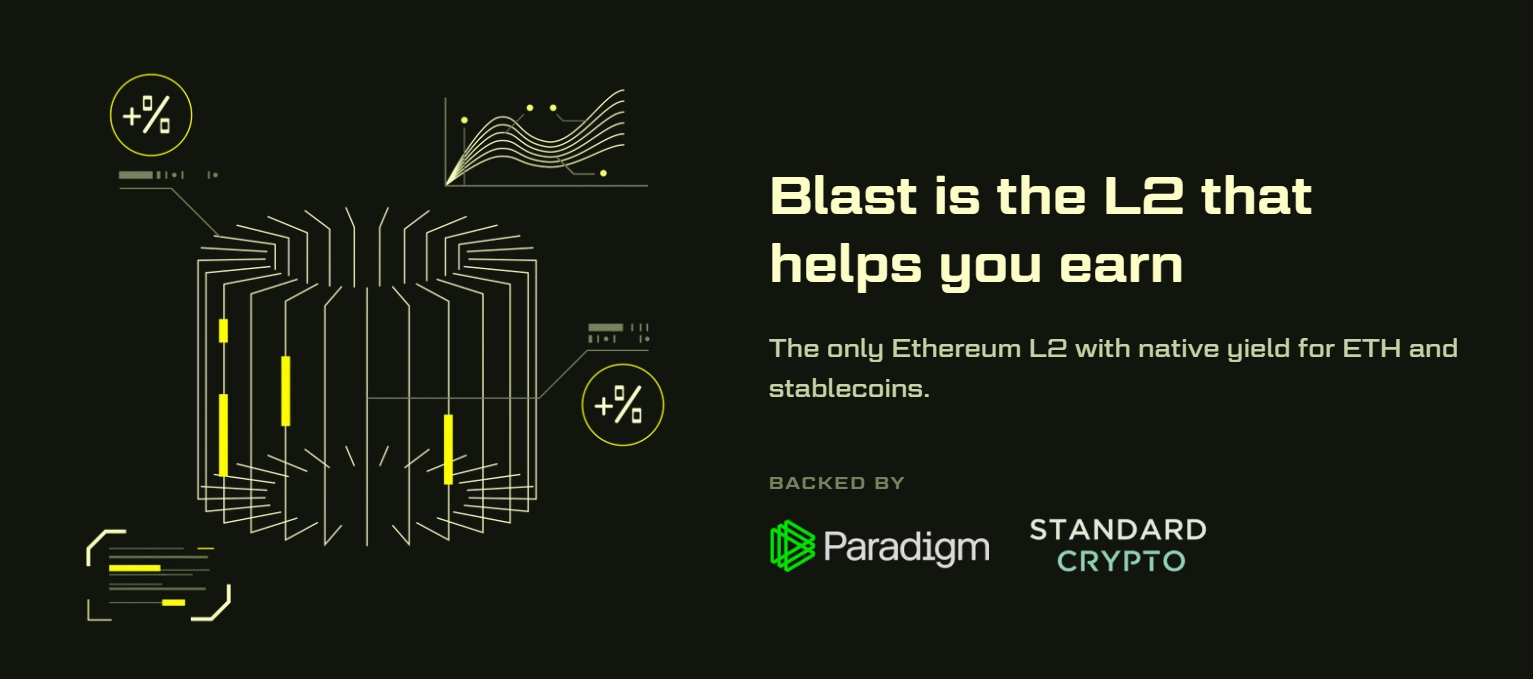what is Blast? More details about Blast
Blast is the first platform that offers attractive profits to users holding ETH and various popular stablecoins. 

What is Blast?
Blast is a blockchain project built with Optimistic Rollup technology on Ethereum. The primary goal of Blast is to generate profits for users holding ETH and stablecoins through staking mechanisms and profit-sharing.
Launched on November 21st, Blast plans to release its token and distribute airdrops in the near future. Early adopters have the opportunity to receive rewards from the project, backed by investments from Paradigm and Standard Crypto.
Blast recently initiated an airdrop program with relatively straightforward requirements. However, it's essential to note that depositing funds and calculating balances before the mainnet launch (February 24, 2024) are off-chain processes, so investors should carefully consider before participating On December 1st, Blast announced that it had reached a TVL (Total Value Locked) of 634 million USD with 67,757 community members. Previously, the project achieved a TVL of 570 million USD within a week. The rapid growth of Blast indicates significant interest from developers and the user community, promising explosive opportunities upon launch.
On December 1st, Blast announced that it had reached a TVL (Total Value Locked) of 634 million USD with 67,757 community members. Previously, the project achieved a TVL of 570 million USD within a week. The rapid growth of Blast indicates significant interest from developers and the user community, promising explosive opportunities upon launch.
Data released on November 28th showed that 63,948 Blast members are earning profit rewards - around 4% for ETH and 5% for stablecoins.
Additionally, the project designed the Blast Point system (Blast Community Airdrop program) to offer users more attractive programs in the future. The airdrop schedule is as follows:
- Early Access (already started) - profit bridge and Blast Point.
- Mainnet (February 24) - dApp goes live, allowing withdrawals.
- Rewards (May 24) - converting Blast Point to reward components
 The rewards from the Blast Community Airdrop are divided into two parts:
The rewards from the Blast Community Airdrop are divided into two parts:
- Early users: receive 50% of the total reward, starting conversion from May 2024.
- Developers: receive 50% of the total reward, granted upon Blast's testnet launch in January 2024.
Key features of Blast
- Real yield: Users deposit ETH and stablecoins to receive rewards directly from the platform. Blast also supports developers in building DApps with similar functionalities. The renowned NFT marketplace, Blur, is the first project supported by Blast.
- Profit-sharing from gas fees: Unlike revenue mechanisms that typically benefit the development team, Blast allocates all revenue to DApp developers. The revenue can be shared with users of the DApps.
- Appealing airdrop program: Blast is implementing a reward program with 50% allocation for developers. The program is expected to reward users when the testnet launches in January.
- Comprehensive toolset: Blast is a layer 2 blockchain compatible with Ethereum, supporting developers in building products similar to those on the layer 1 Ethereum and other layer 2 solutions (Arbitrum, Optimism) in a simple and convenient manner.
Risks of Participating in the Project
Currently, layer 2 Blast has garnered attention for its unique operational mechanism and enticing airdrop program. In addition to direct participation in reward hunting, users can also refer friends, expand the community, and increase the reward rate.
The mechanism that provides quick profits attracts the community rapidly. After a few hours of announcing the airdrop program, Blast received over five million USD in deposits. In a short period, Blast continuously set new records for Total Value Locked (TVL) and the number of users participating in the platform.
Despite its significant appeal to the community, the project has faced numerous controversies surrounding a ponzi-like operating model and excessive centralization. Risks that users may encounter when participating in Blast include:
- Inability to Withdraw Funds: This is one of the main risks users may face with Blast. The withdrawal feature on Blast is only available when the mainnet of the project is launched. All deposited assets are locked and depend on the project's progress. Many experts advise users to exercise caution with this mechanism, possibly using disposable funds to participate and mentally preparing for issues if they arise.
- Extended Asset Lock-Up Period: Blast will lock users' funds for three months. Capital cannot be moved, withdrawn, or invested in other projects during this period.
- Low Profits: Although many users expect the project to deploy a substantial airdrop - with investors like Paradigm and the Blur team - this may not happen, and it is a common risk when participating in airdrops.
Additionally, Blast has faced some technical controversies. Jarrod Watts, an engineer at Polygon Labs, accused Blast of causing security risks due to centralization. Blast uses a 3/5 multisig mechanism, and Watts believes that attackers could gain control of three out of five keys, leading to the theft of all assets.
Watts stated that Blast is not truly a "layer 2" as claimed. Instead, Blast merely "pools money from users" and "stakes it in protocols like LIDO" without the need for actual bridges or test networks.
Despite the project's public rebuttal of accusations and claims of decentralization, operating for the benefit of the community, investors still need to conduct thorough research before deciding to participate.
Contact
- Website: https://blast.io/en
- Discord: https://discord.com/invite/blast-l2
- X (Twitter): https://twitter.com/Blast_L2






![[FAILED] Engage2Earn: McEwen boost for Rob Mitchell](https://cdn.bulbapp.io/frontend/images/c798d46f-d3b8-4a66-bf48-7e1ef50b4338/1)


























![[ℕ𝕖𝕧𝕖𝕣] 𝕊𝕖𝕝𝕝 𝕐𝕠𝕦𝕣 𝔹𝕚𝕥𝕔𝕠𝕚𝕟 - Is Trump Dying? Or Only Killing The Market?](https://cdn.bulbapp.io/frontend/images/a129e75e-4fa1-46cc-80b6-04e638877e46/1)




